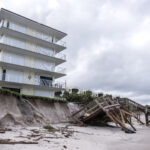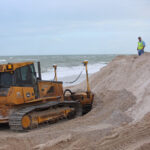By Lisa Zahner
INDIAN RIVER COUNTY – The county’s more than $7 million project to truck in thousands of tons of sand to replenish beaches is in question after state environmental officials said less sand would have to be used in order to protect and offshore reef.Faced with the prospect of reducing the amount of sand placed on beaches by 26 percent to obtain the environmental permits, county staff is now recommending the Board of County Commissioners reconsider the use of upland or trucked-in sand.
“If we use the upland sand, it is a finer grain and we will have to place less sand on the beaches and it will reduce the performance of the project,” said Indian River County Coastal Resources Manager Jonathan Gorham. “There is a near-shore reef that the sand would impact and we’ve submitted a ‘no reef impact’ design.” After months of wrangling with bidders of upland sand who wanted in on the $7-plus million project that would shore up a 6.6-acre tract of beach between Treasure Shores Park and John’s Island, the county may end up awarding the contract to Great Lakes Dredging, at a cost of $8.9 million instead of the $7.2 million quoted by Ranger Construction for the upland sand plan.Bill Glynn, chairman of the Beaches and Shores Preservation Advisory Committee, met with county staffers on Wednesday about the findings and the staff recommendation.
“I told them flat out that a reduction of 26 percent in the amount of sand is absolutely unacceptable,” Glynn said.
Glynn had been a big proponent of using upland sand to bring jobs to the county and keep tax dollars at home, but not at the expense of the eroded beaches and structures that have been in peril since the 2004 hurricanes.
“I was all for using upland sand providers if they could deliver the quality, the timing and the price,” he said. “But I’m not going to do it with the possibility of putting a program out there that won’t do the job. Tallahassee has laid down such strict rules that it all but disqualifies the upland sand sources.”
The county commission will vote Tuesday the matter.
“I’m concerned about getting three out of the five votes,” Glynn said, noting that the issue of getting the sand on the beaches as soon as possible is of dire importance not only to barrier island residents, but to locals and tourists who flock to the county’s beaches.
In a memo dated Oct. 7 to the Indian River Board of County Commissioners, Gorham outlined the problems which arose while modifying the permit applications for the project. He said consultant Michael Walther of Coastal Tech, who was contracted to re-design the project to accommodate the upland sand, had determined that, due to the potential reef impact, “the volume of sand allowed to be placed on the beach has been significantly reduced.”
The memo goes on to say that only 347,663 cubic yards of sand would be placed on the beach instead of the 472,000 cubic yards originally proposed. Ranger Construction, the chosen bidder who has not yet been awarded a contract due to permitting, would only be paid for the cubic yards actually trucked onto the beach.
Some of the most damaged areas in the project would be affected the worst by the changes to the design, with Sea Oaks, for instance, getting only 3,654 cubic yards instead of 11,905 cubic yards, a full 69.4 percent less sand than planned.
“FDEP further stated that, in general, sand of a smaller grain size and of lower placement volume results in significantly reduced project performance and lifespan,” Gorham said in his memo.
The project was to begin sometime in January if permits could be obtained in late November or early December.
Commissioners will consider the item during the regular county commission meeting at 9 a.m. Tuesday in Building A of the Indian River County Administration Complex.






